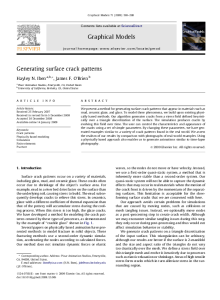Generating Surface Crack Patterns
Abstract
We present a method for generating surface crack patterns that appear in materials such as mud, ceramic glaze, and glass. To model these phenomena, we build upon existing physically based methods. Our algorithm generates cracks from a stress field defined heuristically over a triangle discretization of the surface. The simulation produces cracks by evolving this field over time. The user can control the characteristics and appearance of the cracks using a set of simple parameters. By changing these parameters, we have generated examples similar to a variety of crack patterns found in the real world. We assess the realism of our results by comparison with photographs of real-world examples. Using a physically based approach also enables us to generate animations similar to time-lapse photography.
Citation
Hayley N. Iben and James F. O'Brien. "Generating Surface Crack Patterns". Graphical Models, 71(6):198–208, 2009.
Supplemental Material
Previous Version
This is an expanded version of an earlier paper that was published in SCA 2006. As recipients of the SCA Award for Best Paper, the authors were invited to submit an extended version to Graphical Models.









